

Advantages of Timber Frame and Straw Bale Houses - Green Homes. From 2012-2013, my partner April and I took on the work of building a new home for ourselves.
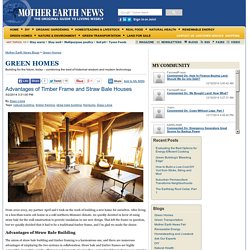
After living in a less-than-warm cob house in a cold northern Missouri climate, we quickly decided in favor of using straw bale for the wall construction to provide insulation in our new design. That left the frame in question, but we quickly decided that it had to be a traditional timber frame, and I'm glad we made the choice. Top 8 Advantages and Challenges of Straw Bale Construction.
Straw Bale Construction Maybe you’ve read about the secret of straw bale construction.

Or you’ve found a newspaper article about this way of building that is efficient and sustainable, beautiful and strong. Possibly you’ve gone by one of my houses as it’s being constructed. And if you’re thinking “Isn’t this too good to be true?” , or “Prove to me this is true!” If you’ve already settled on a project, call (or e-mail) me. Low-Cost Green Home - Straw Bales. Straw Bales Straw bales can be used either as load-bearing structure and insulation or just as insulation filled in around a post-and-beam structure.
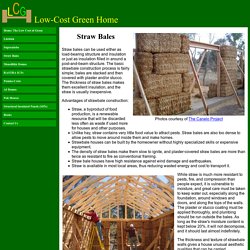
The basic strawbale construction process is fairly simple; bales are stacked and then covered with plaster and/or stucco. The thickness of straw bales makes them excellent insulation, and the straw is usually inexpensive. Advantages of strawbale construction: Straw, a byproduct of food production, is a renewable resource that will be discarded less often as waste if used more for houses and other purposes.
Unlike hay, straw contains very little food value to attract pests. Www.fuentesdesign.com. White Paper: Why Straw Bale Construction?

Find more videos like this on Sustainable Practices Interview with Mark Schuneman of the Colorado Straw Bale Association, and Brian Fuentes, AIA One of my clients, already committed to green construction, recently asked me why straw bale? Sustainable Building Systems. 1.
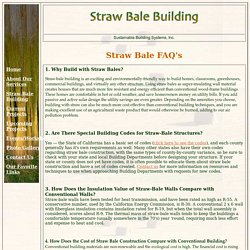
Why Build with Straw Bales? Straw-bale building is an exciting and environmentally-friendly way to build homes, classrooms, greenhouses, commercial buildings, and virtually any other structure. Using straw bales as super-insulating wall material creates houses that are much more fire resistant and energy efficient than conventional wood-frame buildings. These homes are comfortable in hot or cold weather, and save homeowners money on utility bills. If you add passive and active solar design the utility savings are even greater. 2. Yes — the State of California has a basic set of codes (click here to see the codes), and each county generally has it's own requirements as well. Modern Updates to Old-School Building Materials. The old ways never died out entirely, but they fell into disuse as new manufacturing techniques led to houses made with two-by-fours, concrete and steel.
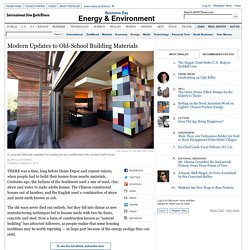
Now a form of construction known as “natural building” has attracted followers, as people realize that some housing traditions may be worth reprising — in large part because of the energy savings they can yield. Homes built with natural materials like straw, sand, earth and rock conserve energy in two ways: Using them cuts down on the pollution that results from producing and transporting manufactured materials, and once the homes are built they can significantly reduce energy costs and consumption.
There are drawbacks: labor costs can be high and concerns raised by city officials and inspectors have the potential to hinder construction. But two processes — using straw bales and rammed earth, a material similar to adobe — are making inroads. Mr. Straw Bale Construction/Characteristics/Insulation. Insulation[edit] UK[edit] Straw in steady state conditions is an unexceptional insulator in the context of insulating materials that are typically considered when designing a building envelope.
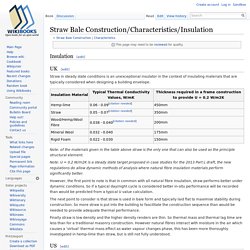
Note: of the materials given in the table above straw is the only one that can also be used as the principle structural element. Note: U = 0.2 W/m2K is a steady state target proposed in case studies for the 2013 Part L draft, the new regulations do allow dynamic methods of analysis where natural fibre insulation materials perform significantly better. However, the first point to note is that in common with all natural fibre insulation, straw performs better under dynamic conditions. The next point to consider is that straw is used in bale form and typically laid flat to maximise stability during construction. Buildingscience. The SystemThe classic and time-proven strawbale wall assembly consists of strawbales laid flat with a 1 to 1.5 inches (25 to 38 mm) thick metal mesh reinforced cement and/or lime stucco skin applied directly to each face.
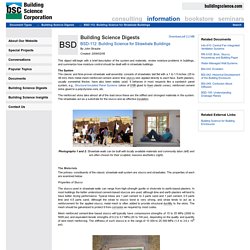
Earth plasters, usually somewhat thicker, have also been widely used. It behaves in most respects like a sandwich panel system, e.g., Structural Insulated Panel Systems (skins of OSB glued to foam plastic cores), reinforced cement skins glued to a polystyrene core, etc. The reinforced skins take almost all of the load since these are the stiffest and strongest materials in the system. The strawbales act as a substrate for the stucco and as effective insulation. Search Results. Life cycle cost and energy analysis of a Net Zero Energy House with solar combisystem.
Centre for Building Studies, Department of Building, Civil and Environmental Engineering, Concordia University, Montreal, Quebec, Canada H3G 1M8 Received 26 June 2010, Revised 27 July 2010, Accepted 29 July 2010, Available online 24 August 2010 Choose an option to locate/access this article: Check if you have access through your login credentials or your institution Check access doi:10.1016/j.apenergy.2010.07.031 Get rights and content Abstract.
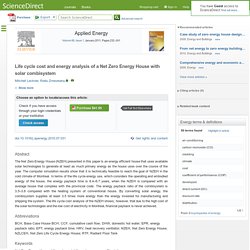
An Error Occurred Setting Your User Cookie. Energyassessmentofastrawbalebuilding. Page. Rainscreen.pdf. PLEA2006_PAPER918.pdf. Residential Energy Consumption Survey (RECS) - Data. Straw Bale Construction: Assessing and Minimizing Embodied Energy. Sustainable earth walls to meet the building regulations. Straw Bale Building On the Cusp of the Mainstream. Determining moisture levels in straw bale construction. BRE Centre for Innovative Construction Materials, Department of Architecture and Civil Engineering, University of Bath, BA2 7AY, United Kingdom Received 11 January 2009, Revised 9 March 2009, Accepted 12 March 2009, Available online 25 April 2009 Choose an option to locate/access this article: Check if you have access through your login credentials or your institution Check access doi:10.1016/j.conbuildmat.2009.03.011 Get rights and content Abstract.
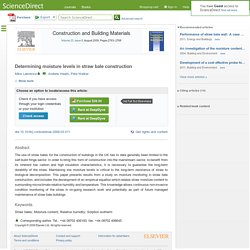
High performance low cost buildings of straw. David A. Bainbridge Dry Lands Research Institute, University of California, Riverside, CA 92521 U.S.A. Accepted 24 March 1986, Available online 27 June 2003 Choose an option to locate/access this article: Check if you have access through your login credentials or your institution. Straw-Bale as a Viable, Cost Effective, and Sustainable Building Material for Use in Southeast Ohio. Thermal Performance of Straw Bale Wall Systems.